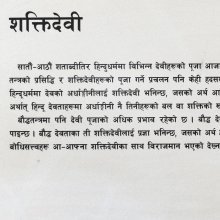Samana, Śamana, Samāna, Samaṇa, Samanā, Śāmana, Sāmana, Shamana, Samānā: 37 definitions
Introduction:
Samana means something in Buddhism, Pali, Hinduism, Sanskrit, Jainism, Prakrit, Marathi, Hindi, biology. If you want to know the exact meaning, history, etymology or English translation of this term then check out the descriptions on this page. Add your comment or reference to a book if you want to contribute to this summary article.
The Sanskrit terms Śamana and Śāmana can be transliterated into English as Samana or Shamana, using the IAST transliteration scheme (?).
Images (photo gallery)
In Hinduism
Ayurveda (science of life)
Source: Wisdom Library: Āyurveda and botanyŚamana (शमन) is a Sanskrit technical term, translating to “pacificatory therapy”. The term is used throughout Ayurvedic literature such as the Suśruta-saṃhitā and the Caraka-saṃhitā.
Source: Google Books: A Practical Approach to the Science of AyurvedaSamāna (समान).—One of the five upadoṣas (sub-functions) of vāta (one of the three biological humors).—
Location of samāna: Stomach and intestinal tract.
Functions of samāna: Stimulating astric juices to break down food and categorizing them into dhātus and malas, digestion, assimilation, controlling svedavaha-srota, jalavaha-srota and doṣavaha-srota (channels).
Ailments of samāna due to vitiation: Dyspepsia or low digestive fire, indigestion, diarrhea and defective assimilation linked to too slow or too rapid digestion.
Source: gurumukhi.ru: Ayurveda glossary of termsŚamana (शमन):—Pacification of vitiated doshas; Palliative therapy.
Source: National Mission for Manuscripts: Traditional Medicine System in IndiaŚamana (शमन) refers to “slowing/pacifying” and is the action (karma) associated with Manda (“dull”): one of the twenty Śārīraguṇa (or Gurvādiguṇa), which refers to the “twenty qualities of the body”—where guṇa (property) represents one of the six divisions of dravya (drugs).—Śārīraka-guṇas are twenty in number. There are ten guṇas with their opposite guṇas. [...] Manda (“dull”) has the predominant bhūta (element) of earth, water and the associated actions of “slowing/pacifying/śamana”; while Tīkṣṇa (“sharp”) has the predominant bhūta (element) of fire and is associated with the action “penetrating/purifying/śodhana”.

Āyurveda (आयुर्वेद, ayurveda) is a branch of Indian science dealing with medicine, herbalism, taxology, anatomy, surgery, alchemy and related topics. Traditional practice of Āyurveda in ancient India dates back to at least the first millenium BC. Literature is commonly written in Sanskrit using various poetic metres.
Purana and Itihasa (epic history)
Source: Cologne Digital Sanskrit Dictionaries: The Purana Index1) Śamana (शमन).—A son of Vadha.*
- * Vāyu-purāṇa 69. 130.
2a) Samāna (समान).—A Tuṣita.*
- * Brahmāṇḍa-purāṇa III. 3. 19: Va. 66. 18.
2b) The 17th kalpa.*
- * Matsya-purāṇa 290. 7.
2c) The mind-born son of Brahmā in the 21st kalpa.*
- * Vāyu-purāṇa 21. 47.

The Purana (पुराण, purāṇas) refers to Sanskrit literature preserving ancient India’s vast cultural history, including historical legends, religious ceremonies, various arts and sciences. The eighteen mahapuranas total over 400,000 shlokas (metrical couplets) and date to at least several centuries BCE.
Natyashastra (theatrics and dramaturgy)
Source: Google Books: Saṅgītaśiromaṇi: A Medieval Handbook of Indian MusicSamāna (समान, “homogeneous”) refers to a musical expression corresponding with māndhātṛ (thoughtful), the seventh word of the elā composition (prabandha).—A sound which manifests itself melodic lines whatsoever, occurring in the so-called middle register, and which moves in between the higher and the lower octave, is called homogeneous (samāna).

Natyashastra (नाट्यशास्त्र, nāṭyaśāstra) refers to both the ancient Indian tradition (shastra) of performing arts, (natya—theatrics, drama, dance, music), as well as the name of a Sanskrit work dealing with these subjects. It also teaches the rules for composing Dramatic plays (nataka), construction and performance of Theater, and Poetic works (kavya).
Vyakarana (Sanskrit grammar)
Source: Wikisource: A dictionary of Sanskrit grammarSamāna (समान).—Common; the same; cf. समान-स्थानकरणा नासिक्यौष्ठ्याः । एतेषां यदेव स्थानं तदेव करणम् (samāna-sthānakaraṇā nāsikyauṣṭhyāḥ | eteṣāṃ yadeva sthānaṃ tadeva karaṇam); V. Pr. I. 80. समानश्च खेदविगमो गम्यायां च अगम्यायां च (samānaśca khedavigamo gamyāyāṃ ca agamyāyāṃ ca) M. Bh. on Ahnika 1.

Vyakarana (व्याकरण, vyākaraṇa) refers to Sanskrit grammar and represents one of the six additional sciences (vedanga) to be studied along with the Vedas. Vyakarana concerns itself with the rules of Sanskrit grammar and linguistic analysis in order to establish the correct context of words and sentences.
Shaktism (Shakta philosophy)
Source: Google Books: Manthanabhairavatantram1) Samanā (समना, “equal”) refers to one of the three bolts of the Santānabhuvana triangle, according to the Ṣaṭsāhasrasaṃhitā, an expansion of the Kubjikāmatatantra: the earliest popular and most authoritative Tantra of the Kubjikā cult.—The Ṣaṭsāhasrasaṃhitā identifies this triangle with the whole of the Western Tradition (paścimāmnāya), as the House of the Moon (candragṛha). It is also called Candrapurī as is the Triangle described in chapter three of the Kumārikākhaṇḍa. But note that although they are similar, they are not the same. Both are made up of a series of triads. The one described in the Ṣaṭsāhasrasaṃhitā has a few more compared to the one described in the Kumārikākhaṇḍa, namely, the doorkeepers, Bhairavas, doors, and bolts [i.e., Samanā].
2) Samanā (समना) refers to “the equal one”, according to the Ṣaṭsāhasrasaṃhitā, an expansion of the Kubjikāmatatantra: the earliest popular and most authoritative Tantra of the Kubjikā cult.—Accordingly, “A, U and Ma along with the Point (bindu) are in the heart, throat, and palate (respectively). The (Half) Moon, the Obstructress (nirodhikā), Sound (nāda), the End of Sound (nādānta), Power (śakti), the Pervasive One (vyāpinī), the Equal One (samanā) and the Transmental (unmanā) are (with the initial four) said to be the twelve supports (ādhāra). (Yogis) know that that is the End of the Twelve by making use (of the seed-syllable) A U Ma. [...]”.
3) Samanā (परमेश्वरी) refers to “she who is with mind ”, representing an aspect of Parameśvarī (Śivā), according to the Devīpañcaśataka, an important source of the Kālīkrama that developed in Kashmir after the Kālī Mata of the Jayadrathayāmala.—Accordingly, “The Great God—Mahādeva—is beyond Śakti, supreme bliss, [...] O Supreme Lord! By his awakening, that supreme Kālikā has spontaneously arisen (svecchayā), the one supreme power endowed with those same attributes. She is subtle, supreme, tranquil [i.e., śāntā], and delighted by supreme bliss. Śivā has arisen spontaneously (svabhāvata); stainless, she is (all that is) knowable. She is the Supreme Goddess (parameśvarī) who, by her own will, is (both) the Transmental (unmanā) (‘Without Mind’) and With Mind (samanā)”.
4) Samanā (समना) refers to the “equal one” and represents one of the seventeen stages of the rise of kuṇḍalinī, according to Abhinavagupta as drawn from the Devyāyāmala.—Cf. The seventeen syllables [i.e., saptadaśākṣara] of Mantramātā.—[...] These seventeen units [are] to be arranged in as many locations along the axis of the subtle body, [as was] clearly known to Abhinava. Thus he presents an ascending series marking the stages of the rise of Kuṇḍalinī, the highest stage of which is that of the ‘Pure Self’ heralded by the Transmental just below it. In this set-up, drawn by Abhinavagupta from the Devyāyāmala, there are seventeen stages. These are [e.g., the Equal One (samanā), ...].
Jayaratha quotes this [Devyāyāmala] Tantra as a source of [Kālasaṃkarṣiṇī’s] Vidyā consisting of seventeen syllables. As the Devyāyāmala tells us that these places are related to the recitation of mantra, we may conclude that the seventeen syllables are contemplated in these seventeen places [e.g., Equal One (samanā)]. Accordingly, the Wheel of the Self can be said to be at the end of (i.e. after) the sixteen [i.e., ṣoḍaśānta].
5) Samanā (समना) refers to the “equal one”, representing one of the “sixteen stations of the ascent of kuṇḍalinī”, according to the Manthānabhairavatantra, a vast sprawling work that belongs to a corpus of Tantric texts concerned with the worship of the goddess Kubjikā.—Accordingly, “[...] (14) Once that has been abandoned and one travels upwards, (one reaches) the one called the Equal One (samanā), which is full of vitality (ojikā). This energy (kalā), established in the middle of the capsule of emission, rains down nectar. [...]”.
6) Samanā (समना) or “the equal one” is associated with Lakuleśvara: one of the nine Bhairava associated with the nine energies of Navātman, according to the Manthānabhairavatantra.—[Note: this passage is drawn from the Gurukramasūtra]—Another way in which the nine energies of Navātman may be understood are as nine aspects of the Command that generates the Bhairavas corresponding to its nine letters. [...] In this case Navātman is SHKṢMLVRYŪ(Ṃ): [...] Lakuleśvara (Ha) by the Equal One (samanā). [...] (This) is the excellent teacher within the tradition. He who knows the teacher here is the delight of Kula.

Shakta (शाक्त, śākta) or Shaktism (śāktism) represents a tradition of Hinduism where the Goddess (Devi) is revered and worshipped. Shakta literature includes a range of scriptures, including various Agamas and Tantras, although its roots may be traced back to the Vedas.
Shaivism (Shaiva philosophy)
Source: SOAS University of London: Protective Rites in the Netra TantraŚamana (शमन) refers to the “ceasing” (of the bonds), according to the Netratantroddyota commentary on the Netratantra of Kṣemarāja: a Śaiva text from the 9th century in which Śiva (Bhairava) teaches Pārvatī topics such as metaphysics, cosmology, and soteriology.—Accordingly, [verse 4.5cd-6, while describing the purification process of the initiand]—“[...] [And after that,] [the bonds] have been reduced to ashes and reside there (tatsthite). [He continues to use the same astramantra [and] reduces to ashes the bonds, which completely cease (śamana—pāśānāṃ śamanam) and are without latent trace. [The locative of] tatsthita means he has visualized oneness of the consciousness of the disciple with the mūla [mantra]. The entirety [of the disciple's] body has ceased. [...]”.

Shaiva (शैव, śaiva) or Shaivism (śaivism) represents a tradition of Hinduism worshiping Shiva as the supreme being. Closely related to Shaktism, Shaiva literature includes a range of scriptures, including Tantras, while the root of this tradition may be traced back to the ancient Vedas.
General definition (in Hinduism)
Source: Wisdom Library: HinduismŚamana (शमन, “the settler”):—One of the epiteths of Yama, the vedic God of death, who is the embodiment of Dharma. Yama rules over the kingdom of the dead and binds humankind according to the fruits of their karma.
Source: Yoga Magazine: PranaThe second prana is known as Samana. The word sam means ‘equal’ or ‘same’. Samana is located between the diaphragm and the navel. Although it is a small area physically, it is very important. Samana is responsible for the digestive energy and coordinates and motivates the digestive organs such as the stomach, liver, pancreas and large intestine. If anything goes wrong with your samana energy then you will become weak and thin because you will not be able to absorb the nutrients in the food properly. It takes a tremendous amount of energy to digest, burn and separate the nutrients which we take in daily. That is one of the greatest pranic expenditures within our body.
In Buddhism
Theravada (major branch of Buddhism)
Source: Access to Insight: A Glossary of Pali and Buddhist TermsContemplative. Literally, a person who abandons the conventional obligations of social life in order to find a way of life more "in tune" (sama) with the ways of nature.Source: Pali Kanon: Pali Proper Names1. A class of Devas present at the preaching of the Mahasamaya Sutta. D.ii.260.
2. One of the chief lay supporters of Kakusandha Buddha. Bu.xxiii.22.
3. The eldest of the seven daughters of King Kiki. She was Khema in the present age. J.vi.481; Ap.ii.546; ThigA.18, etc.
Theravāda is a major branch of Buddhism having the the Pali canon (tipitaka) as their canonical literature, which includes the vinaya-pitaka (monastic rules), the sutta-pitaka (Buddhist sermons) and the abhidhamma-pitaka (philosophy and psychology).
Mahayana (major branch of Buddhism)
Source: Wisdom Library: Maha Prajnaparamita SastraSamaṇa is the brother of the Brāhman named Akkosaka, according to the Akkossasutta of the Saṃyutta (also see the 2nd century Mahāprajñāpāramitāśāstra chapter XLII).—The Buddha was dwelling at Rājagaha at the Veḷuvana in the Kalandakanivāpa. Akkosaka-Bhāradvāja came to find him and, furious to learn that his brother Samaṇa had just entered the bhikṣu community, he insulted and outraged the Blessed One with coarse and harmful words. The Buddha’s only response was to ask him if sometimes he welcomed friends and relatives at his home and if, in the affirmative, he offered them food. Akkosaka acknowledged that sometimes that happened. And if the guests refuse the food that you offer them, said the Buddha, to whom does this food belong?—It returns to me, answered the Brāhman. In the same way, continued the Buddha, by not responding to your insults by means of insults, we let you take them into account: it is to you that they return, O Brāhman.
Source: WikiPedia: Mahayana BuddhismŚamana (शमन) or “pacifying” refers to one of the “nine mental abidings” (i.e., ‘nine stages of training the mind’) connected with śamatha (“access concentration”), according to Kamalaśīla and the Śrāvakabhūmi section of the Yogācārabhūmi-śāstra.—Śamana (Tibetan: ཞི་བར་བྱེད་པ་, zhi-bar byed-pa) or “pacifying” is the stage during which subtle mental dullness or laxity is no longer a great difficulty, but now the practitioner is prone to subtle excitements which arise at the periphery of meditative attention. According to B. Alan Wallace this stage is achieved only after thousands of hours of rigorous training.

Mahayana (महायान, mahāyāna) is a major branch of Buddhism focusing on the path of a Bodhisattva (spiritual aspirants/ enlightened beings). Extant literature is vast and primarely composed in the Sanskrit language. There are many sūtras of which some of the earliest are the various Prajñāpāramitā sūtras.
General definition (in Buddhism)
Source: Wisdom Library: BuddhismSamaṇa; The Pali word for shramana (a wandering monk; a shramana is one who renounces the world and leads an ascetic life for the purpose of spiritual development and liberation)
Source: Buddhist Door: GlossaryA Pali word, Sramana in Sanskrit. One who practices austerities; an ascetic.Source: Amaravati: Glossaryone who has entered the Holy Life; a religious; originally, a religious recluse or wanderer.
In Jainism
General definition (in Jainism)
Source: archive.org: TrisastisalakapurusacaritraSamāna (समान) (or Samānaka) and Sannihita are the two Indras of the Aprajñaptika class Vyantaras living in the first 100 yojanas of the Ratnaprabhā-earth in the “lower world” (adhaloka), according to chapter 2.2 [ajitanātha-caritra] of Hemacandra’s 11th century Triṣaṣṭiśalākāpuruṣacaritra: an ancient Sanskrit epic poem narrating the history and legends of sixty-three illustrious persons in Jainism.
Accordingly: “[...] In the first 100 yojanas of Ratnaprabhā, with the exception of 10 above and 10 below, i.e., in 80 yojanas, there are 8 classes of Vyantaras: [viz., the Aprajñaptikas, ...] The two Indras in these classes are respectively: [viz., Sannihita and Samāna;...]”.

Jainism is an Indian religion of Dharma whose doctrine revolves around harmlessness (ahimsa) towards every living being. The two major branches (Digambara and Svetambara) of Jainism stimulate self-control (or, shramana, ‘self-reliance’) and spiritual development through a path of peace for the soul to progess to the ultimate goal.
Biology (plants and animals)
Source: Google Books: CRC World Dictionary (Regional names)Samana in Tibet is the name of a plant defined with Pterocarpus marsupium in various botanical sources. This page contains potential references in Ayurveda, modern medicine, and other folk traditions or local practices It has the synonym Pterocarpus bilobus Roxb. ex G. Don (among others).
Example references for further research on medicinal uses or toxicity (see latin names for full list):
· Journal of Cytology and Genetics (1990)
· Revisio Generum Plantarum (1891)
· Journal of the Asiatic Society of Bengal.
· Ethnobotany (2004)
· A General History of the Dichlamydeous Plants (1832)
· Natural history (1897)
If you are looking for specific details regarding Samana, for example diet and recipes, pregnancy safety, extract dosage, side effects, chemical composition, health benefits, have a look at these references.

This sections includes definitions from the five kingdoms of living things: Animals, Plants, Fungi, Protists and Monera. It will include both the official binomial nomenclature (scientific names usually in Latin) as well as regional spellings and variants.
Languages of India and abroad
Pali-English dictionary
Source: BuddhaSasana: Concise Pali-English Dictionary1) samaṇa : (m.) a recluse.
2) samaṇī : (f.) a nun.
3) samāna : (adj.) equal; same; similar.
Source: Sutta: The Pali Text Society's Pali-English Dictionary1) Samana, (nt.) (fr. śam) suppression Mhvs 4, 35. (Page 683)
2) Samāna, 2 (ppr. fr. as to be) 1. being, existing D. I, 18, 60; J. I, 218; PvA. 129 (=santo), 167 (id.).—2. a kind of god D. II, 260.
3) Samāna, 1 (adj.) (Vedic samāna, fr. sama3) similar, equal, even, same Sn. 18, 309; J. II, 108. Cp. sāmañña1. (Page 685)
4) Samaṇa, (BSk. śramaṇa, fr. śram, but mixed in meaning with śam) a wanderer, recluse, religieux A. I, 67; D. III, 16, 95 sq. , 130 sq.; S. I, 45; Dh. 184; of a non-Buddhist (tāpasa) J. III, 390; an edifying etymology of the word DhA. III, 84: “samita-pāpattā s. , ” cp. Dh. 265 “samitattā pāpānaṃ “samaṇo” ti pavuccati”; four grades mentioned D. II, 151; M. I, 63; compare Sn. 84 sq.; the state of a Samaṇa is attended by eight sukhas J. I, 7; the Buddha is often mentioned and addressed by nonBuddhists as Samaṇa: thus D. I, 4, 87; Sn. p. 91, 99; Vin. I, 8 350; Samaṇas often opposed to Brāhmaṇas: thus, D. I, 13; It. 58, 60; Sn, p. 90; Vin. I, 12; II, 110; samaṇabrāhmaṇā, Samaṇas and Brāhmaṇas quite generally: “leaders in religious life” (cp. Dial. II. 165) D. I, 5; II, 150; A. I, 110, —173 sq.; It. 64; Sn. 189; Vin. II, 295; samaṇadhammaṃ the duties of a samaṇa A. III, 371; J. I, 106, 107, 138; pure-samaṇa a junior who walks before a Bhikkhu Vin. II, 32; pacchāsamaṇa one who walks behind Vin. I, 186; II, 32; A. III, 137.—samaṇī a female recluse S. I, 133; ThA. 18; J. V, 424, 427; Vin. IV, 235.—assamaṇa not a true samaṇa Vin. I, 96.

Pali is the language of the Tipiṭaka, which is the sacred canon of Theravāda Buddhism and contains much of the Buddha’s speech. Closeley related to Sanskrit, both languages are used interchangeably between religions.
Marathi-English dictionary
Source: DDSA: The Molesworth Marathi and English Dictionaryśamana (शमन).—n S Quieting, stilling, calming, composing. 2 In medicine. Allaying or soothing. See saptōcāra. 3 A composer or settler; a medicine or a measure that assuages or abates pain or excitement; an anodyne. Ex. pittācēṃ śamana suṇṭhasākara. 4 Becoming quiet, still, calm, composed.
--- OR ---
śāmāṇā (शामाणा) [or ना, nā].—m ( P) A cloth stretched in front or rear of a tent: also an awning generally.
--- OR ---
samāna (समान).—a ( A) Eight. Used of the Arabic year.
--- OR ---
samāna (समान).—a (S) Even, level, smooth. 2 Like, similar, equal. In this sense useful compounds occur, and others wait to be evoked by the proficient. Ex. samānagōtra, sa0 jāti -dharma -duḥkha -sukha- duḥkha -bala -sāmarthya -parākrama, -pratāpa -vibhava -vikrama -vyasana, samānōddēśa, samānōdyōga &c. Such, being of obvious sense or power, occur not in order. 3 One, same, identical.
--- OR ---
samāna (समान).—m S That vital air which is considered essential to digestion. See prāṇa & upaprāṇa.
--- OR ---
sāmanā (सामना).—m unc ( H) Oppositeness: also confrontedness.
--- OR ---
sāmāna (सामान).—n ( P) Instruments, implements, tools; apparatus, furniture, necessaries, things; the materials or the means required for a business or work. 2 Goods, chattels, articles of property, baggage, traps, kit.
Source: DDSA: The Aryabhusan school dictionary, Marathi-Englishśamana (शमन).—n Quieting. A settler. Becoming calm. Allaying.
--- OR ---
samāna (समान).—a Even; like.
--- OR ---
sāmanā (सामना).—m Oppositeness; confrontedness. A duel. A match-as of cricket.
--- OR ---
sāmāna (सामान).—n Instruments; apparatus. Goods.
Marathi is an Indo-European language having over 70 million native speakers people in (predominantly) Maharashtra India. Marathi, like many other Indo-Aryan languages, evolved from early forms of Prakrit, which itself is a subset of Sanskrit, one of the most ancient languages of the world.
Sanskrit dictionary
Source: DDSA: The practical Sanskrit-English dictionaryŚamana (शमन).—a. (-nī f.) [शम् णिच् ल्यु ल्युट् वा (śam ṇic lyu lyuṭ vā)] Quelling, allaying, subduing &c.
-nam 1 Appeasing, allaying, soothing, conquering, alleviating, &c.
2) Calmness, tranquillity.
3) End, stop, cessation, destruction.
4) Hurting, injuring; destroying; सपत्नशमनम् (sapatnaśamanam) Mahābhārata (Bombay) 3.85.11.
5) Killing animals for sacrifice, immolation.
6) Swallowing, chewing.
-naḥ 1 A kind of deer, an antelope.
2) Name of Yama, the god of death; शतशस्तत्र यवनाः शम- नातिथयोऽभवन् (śataśastatra yavanāḥ śama- nātithayo'bhavan) Śiva B.14.94.
3) A kind of pea.
--- OR ---
Śāmana (शामन).—Name of Yama.
-nam 1 Killing, slaughter.
2) Tranquillity, peace.
3) End.
4) Sedative.
-nī The southern direction.
Derivable forms: śāmanaḥ (शामनः).
--- OR ---
Samāna (समान).—a.
1) Same, one, equal, like, similar; नोपगच्छेत् प्रमत्तोऽपि स्त्रियमार्तवदर्शने । समानशयने चैव न शयीत तया सह (nopagacchet pramatto'pi striyamārtavadarśane | samānaśayane caiva na śayīta tayā saha) || Manusmṛti 4.4; भुजे भुजंगेन्द्रसमानसारे (bhuje bhujaṃgendrasamānasāre) R.2.74; समानशीलव्यसनेषु सख्यम् (samānaśīlavyasaneṣu sakhyam) Subhāṣ.
2) One, uniform.
3) Good, virtuous, just.
4) Common, general.
5) Honoured.
6) Middling, moderate.
7) Whole (as a number).
-naḥ 1 A friend, an equal.
2) One of five life-winds or vital airs, which has its seat in the cavity of the navel and is essential to digestion.
3) A letter having the same organ of utterance.
-nam ind. Equally with, like (with instr.); जलधरेण समानमुमापतिः (jaladhareṇa samānamumāpatiḥ) Kirātārjunīya 18.4.
--- OR ---
Sāmana (सामन).—a. Ved. Conciliatory, peaceable.
Source: Cologne Digital Sanskrit Dictionaries: Edgerton Buddhist Hybrid Sanskrit DictionarySamāna (समान).—adj. or pres. pple. (= Pali id., also AMg., [Page569-b+ 71] [Jaina Māhārāṣṭrī] °ṇa, Pischel 561; = Sanskrit sant), being; like Sanskrit sant, often seems nearly superfluous: duḥkhaskandhena spṛṣṭāḥ °nā na duḥkhaṃ manasi kurvanti Saddharmapuṇḍarīka 72.15; sa utpannaḥ °naḥ paśyati 77.12; others, prose, 110.2; 216.8; 289.7; 290.11; Lalitavistara 51.16; 89.9 (te cyutāḥ samānā avīcau… prapatiṣyanti); 410.19; Mahāvastu i.311.19; 321.11; 362.6; ii.65.12 (tāṃ godhāṃ pakvāṃ °nāṃ dṛṣṭvā); 90.12; 96.13; 111.3; 119.4 (not samāna, like; evaṃdarśanaṃ ca °naṃ samā- nārthatāye [this samāna = like] sthāpayet); 242.11; 247.15; 276.19 ff.; 461.20; iii.49.12; 51.5 ff.; 198.9; 222.18; 302.4; 403.11; Divyāvadāna 651.6 ff.; Suvarṇabhāsottamasūtra 21.1; 91.11; 92.8; Rāṣṭrapālaparipṛcchā 34.11 (read pravrajitāḥ samānā, separate word); 41.12 (viṃśavarṣāḥ °nāḥ ṣoḍaśavarṣātikrāntāḥ kumārakāḥ, youths of [sc. up to?] 20 and more than 16 years of age?); Kāśyapa Parivarta 106.7; Sukhāvatīvyūha 19.4; Karmavibhaṅga (and Karmavibhaṅgopadeśa) 65.3; 67.20; verses, Saddharmapuṇḍarīka 11.13; Mahāvastu i.163.4; Suvarṇabhāsottamasūtra 47.9 (jāta-samāna-prabhāsita- gātraṃ, upon being born, i.e. as soon as born…); etc., common.
Source: Cologne Digital Sanskrit Dictionaries: Shabda-Sagara Sanskrit-English DictionaryŚamana (शमन).—n.
(-naṃ) 1. Killing animals for sacrifice, immolation. 2. Mental tranquillity, calmness, indifference. 3. Abuse, malediction. 4. Hurt, injury. 5. Chewing, swallowing. 6. The act of appeasing, soothing, consoling. 7. Cessation, end, destruction. m.
(-naḥ) 1. Yama, the ruler of Tartarus. 2. An antelope. f. (-nī) Night. E. śam to be tranquil, aff. lyuṭ or yuc .
--- OR ---
Śāmana (शामन).—n.
(-naṃ) 1. Killing, slaughter. 2. Tranquillity, peace. m.
(-naḥ) An epithet of Yama. E. śam to be pacified, causal form, lyuṭ aff.
--- OR ---
Samāna (समान).—mfn.
(-naḥ-nā-naṃ) 1. Like, similar. 2. Good, virtuous. 3. One, uniform, same. 4. Honoured. m.
(-naḥ) 1. One of the five vital airs, that which is considered essential to digestion and occupies the cavity of the navel. 2. A corresponding letter of the alphabet, as a long vowel to its short one, &c. 3. A friend. E. sama all, an to breathe, aff. aṇ or ghañ; or sam and āṅ before ṇī to get, aff. ac .
Source: Cologne Digital Sanskrit Dictionaries: Benfey Sanskrit-English DictionaryŚamana (शमन).—[śam + ana], I. n. 1. Calmness. 2. End; with yā, To be destroyed, [Pañcatantra] iii. 31, v. r. (cf. my translation and Böhtl. Ind. Spr. 1868). 3. Immolation. 4. Hurt, injury. 5. Abuse, malediction. Ii. m. 1. An antelope, 2. Yama. Iii. f. nī, The night.
--- OR ---
Śāmana (शामन).—i. e. śam, anomal. [Causal.], + ana, n. 1. Killing. 2. Tranquillity. 3. End; with yā, To be destroyed, [Pañcatantra] iii. 31 (but cf. my tranel.).
--- OR ---
Samana (समन).—probably sam-an + a, m. 1. Zeal. 2. A diligent man,
--- OR ---
Samāna (समान).—[sa-māna]A. i. e., I. adj., f. nā and nī. 1. Like, similar, equal, [Vikramorvaśī, (ed. Bollensen.)] [distich] 110; [Pañcatantra] ii. [distich] 26. 2. Same,
Śamana (शमन).—[adjective] ([feminine] ī) & [neuter] tranquillizing, stilling, allaying; [neuter] also killing, destroying.
--- OR ---
Samana (समन).—[neuter] meeting, encounter, intercourse, assembly, embrace; contest, fight.
--- OR ---
Samanā (समना).—[adverb] in one point, together; at once, simultaneously; equally, in like manner.
--- OR ---
Samāna (समान).—1. [feminine] ī & ā like, same, similiar, homogeneous, equal to ([instrumental], [genetive], or —°), common, universal, all; °— & [neuter] [adverb] equally, like ([instrumental] or —°).
--- OR ---
Samāna (समान).—2. [masculine] one of the vital airs.
Source: Cologne Digital Sanskrit Dictionaries: Aufrecht Catalogus CatalogorumSamāna (समान) as mentioned in Aufrecht’s Catalogus Catalogorum:—vaid. Oppert. 1053. Ii, 1395. 3080. 9119.
—[commentary] Ii, 9120. See Śākhāsamāna.
1) Śamana (शमन):—[from śam] mf(ī)n. calming, tranquillizing, soothing, allaying, extinguishing, destroying, [Kātyāyana-śrauta-sūtra; Mahābhārata] etc.
2) [v.s. ...] m. ‘settler, destroyer’, Name of Yama, [Daśakumāra-carita]
3) [v.s. ...] a kind of antelope, [cf. Lexicographers, esp. such as amarasiṃha, halāyudha, hemacandra, etc.]
4) [v.s. ...] a kind of pea, [cf. Lexicographers, esp. such as amarasiṃha, halāyudha, hemacandra, etc.]
5) [from śam] n. the act of calming, appeasing, allaying, tranquillization, pacification, extinction, destruction, [Kauśika-sūtra; Mahābhārata] etc. killing, slaying, immolation, [Kauśika-sūtra]
6) [v.s. ...] chewing, swallowing, [cf. Lexicographers, esp. such as amarasiṃha, halāyudha, hemacandra, etc.]
7) [v.s. ...] a mode of sipping water ([probably] for camana), [Monier-Williams’ Sanskrit-English Dictionary]
8) [v.s. ...] malediction, reviling ([wrong reading] for śapana), [Horace H. Wilson]
9) Śāmana (शामन):—[from śāma] mfn. extinguishing, destroying, [Pañcatantra iii, 31] ([varia lectio] for śamana)
10) [v.s. ...] m. Name of Yama (= śamana), [Horace H. Wilson]
11) [from śāma] n. a sedative, [Caraka]
12) [v.s. ...] tranquillity, peace, [Horace H. Wilson]
13) [v.s. ...] killing, slaughter, [ib.]
14) [v.s. ...] end (naṃ-√yā, to go to an end, be destroyed), [Monier-Williams’ Sanskrit-English Dictionary]
15) [Cf. Sanmāna]
16) Samāna (समान):—[=sam-āna] [from sam-an] a m. (for samāna and sa-māna See p.1160) one of the five vital airs (that which circulates about the navel and is essential to digestion; it is personified as a son of Sādhya), [Atharva-veda]; etc.
17) Samana (समन):—n. ([probably] connected with 2. sam, or 2. sama) meeting (cf. a-samana), assembly, concourse, festival, [Ṛg-veda; Atharva-veda]
18) intercourse, commerce, pursuit, [Ṛg-veda i, 48, 6]
19) amorous union, embrace, [Ṛg-veda vi, 75, 4 etc.]
20) conflict, strife, [ib. vi, 73, 3; 5 etc.] ([Naighaṇṭuka, commented on by Yāska ii, 17]).
21) Samanā (समना):—[from samana] ind. in one point, together, [Ṛg-veda]
22) [v.s. ...] at a time, all at once, [ib.]
23) [v.s. ...] likewise, uniformly, [ib.]
24) Samāna (समान):—b mf(ī, or ā)n. (connected with 1. and 2. sama; in [Ṛg-veda v, 87, 4] [ablative] sg. samānasmāt for samānāt See 1. sama; for sam-ana See sam-√an, for sa-māna See [column]3) same, identical uniform, one (= eka, [cf. Lexicographers, esp. such as amarasiṃha, halāyudha, hemacandra, etc.]), [Ṛg-veda] etc. etc.
25) alike, similar, equal (in size, age, rank, sense or meaning etc.), equal or like to (with [instrumental case] [genitive case], or [compound]), [Vājasaneyi-saṃhitā] etc. etc.
26) having the same place or organ of utterance, homogeneous (as a sound or letter), [Vopadeva]
27) holding the middle between two extremes, middling moderate, [Bhāgavata-purāṇa]
28) common, general, universal, all, [Ṛg-veda; Brāhmaṇa; ???; Bhāgavata-purāṇa]
29) whole (as a number, opp. to ‘a fraction’), [Pāṇini 5-2, 47], [vArttika] 4
30) being (= sat, after an [adjective (cf. [masculine, feminine and neuter; or adjective])]), [Divyāvadāna]
31) virtuous, good, [cf. Lexicographers, esp. such as amarasiṃha, halāyudha, hemacandra, etc.]
32) = varṇa-bhid, [cf. Lexicographers, esp. such as amarasiṃha, halāyudha, hemacandra, etc.]
33) m. an equal, friend, [Taittirīya-brāhmaṇa; Cāṇakya; Bhāgavata-purāṇa]
34) ([probably]) n. Name of [work] (cf. śākhā-s).
35) [=sa-māna] 1. sa-māna mfn. (for samāna See [column]1; for sam-āna See p. 1154, col. 2) possessing honour or esteem, honoured by ([genitive case]), [Vetāla-pañcaviṃśatikā]
36) [v.s. ...] with anger, [Bhāgavata-purāṇa]
37) [=sa-māna] 2. sa-māna mfn. (for 1. See above) having the same measure, [cf. Lexicographers, esp. such as amarasiṃha, halāyudha, hemacandra, etc.]
38) Sāmana (सामन):—[from sāman] 1. sāmana mf(ā)n. (for 2. See under 2. sāman) rich, affluent, abundant (others ‘common, universal’), [Ṛg-veda iii, 30, 9.]
39) [from sāman] 2. sāmana mfn. (for 1. See under 1. sāman) quiet, calm, [Ṛg-veda x, 85, 9.]
40) Sāmāna (सामान):—Vṛddhi form of 2. samāna in [compound]
Source: Cologne Digital Sanskrit Dictionaries: Yates Sanskrit-English Dictionary1) Śamana (शमन):—(naṃ) 1. n. Immolation; tranquillity; hurt; malediction. 1. m. Yama f. (ī) night.
2) Śāmana (शामन):—(naṃ) 1. n. Killing; tranquillity.
3) [Cf. Sanmāna]
4) Samāna (समान):—[(naḥ-nā-naṃ) m.] One of the vital airs. a. Same, similar, good.
Source: DDSA: Paia-sadda-mahannavo; a comprehensive Prakrit Hindi dictionary (S)Śamana (शमन) in the Sanskrit language is related to the Prakrit words: Samaṇa, Samāṇa, Sāmāṇa.
[Sanskrit to German]
Sanskrit, also spelled संस्कृतम् (saṃskṛtam), is an ancient language of India commonly seen as the grandmother of the Indo-European language family (even English!). Closely allied with Prakrit and Pali, Sanskrit is more exhaustive in both grammar and terms and has the most extensive collection of literature in the world, greatly surpassing its sister-languages Greek and Latin.
Hindi dictionary
Source: DDSA: A practical Hindi-English dictionary1) Śamana (शमन) [Also spelled shaman]:—(nm) (the act or process of) pacification, allaying; quenching; suppression; —[karanā] to pacify, to allay; to quench; to suppress.
2) Sanmāna (सन्मान):—(nm) see [sammāna].
3) Samana (समन) [Also spelled saman]:—(nm) summons; —[tāmīla karanā] to serve summons (on).
4) Samāna (समान) [Also spelled saman]:—(a) equal, equivalent; similar, alike, identical; tantamount; ~[tā] equality, equivalence; parity, similarity, likeness.
5) Samānā (समाना):—(v) to be contained (in); to enter; to fit (in); to permeate.
6) Sāmanā (सामना) [Also spelled samna]:—(nm) confrontation, encounter, meeting; opposition; frontage.
7) Sāmāna (सामान) [Also spelled saman]:—(nm) goods; luggage, bag and baggage; material, stuff; stock; ~[ghara] luggage office; —[karanā] to make preparations; to prepare the ground (for).
...
Prakrit-English dictionary
Source: DDSA: Paia-sadda-mahannavo; a comprehensive Prakrit Hindi dictionary1) Samaṇa (समण) in the Prakrit language is related to the Sanskrit word: Śamana.
2) Samaṇa (समण) also relates to the Sanskrit word: Samaṇa.
3) Samaṇa (समण) also relates to the Sanskrit word: Śramaṇa.
4) Samāṇa (समाण) also relates to the Sanskrit word: Bhuj.
5) Samāṇa (समाण) also relates to the Sanskrit word: Samāp.
6) Samāṇa (समाण) also relates to the Sanskrit word: Samāna.
7) Samāṇa (समाण) also relates to the Sanskrit word: Sat.
8) Sāmaṇa (सामण) also relates to the Sanskrit words: Śrāmaṇa, Ṇika.
Sāmaṇa has the following synonyms: Sāmaṇiya.
9) Sāmāṇa (सामाण) also relates to the Sanskrit word: Sāmāna.
Prakrit is an ancient language closely associated with both Pali and Sanskrit. Jain literature is often composed in this language or sub-dialects, such as the Agamas and their commentaries which are written in Ardhamagadhi and Maharashtri Prakrit. The earliest extant texts can be dated to as early as the 4th century BCE although core portions might be older.
Kannada-English dictionary
Source: Alar: Kannada-English corpusŚamana (ಶಮನ):—
1) [noun] the act of calming, tranquilising or soothing; tranquilisation; pacification.
2) [noun] the act of preventing, warding off; prevention.
3) [noun] the act of alleviating, mitigating (suffering, misery, etc.).
4) [noun] the act of destroying; destruction.
5) [noun] an offering of an animal as an oblation in a sacrifice.
6) [noun] Yama, the God of Death and Righteousness.
--- OR ---
Śamana (ಶಮನ):—[noun] a loose long cloth to cover the upper portion of the body or worn loosely above the upper garment.
--- OR ---
Śāmana (ಶಾಮನ):—
1) [noun] the act of calming, tranquilising or soothing; tranquilisation; pacification.
2) [noun] the act of alleviating, mitigating (suffering, misery, etc.).
--- OR ---
Samaṇa (ಸಮಣ):—
1) [noun] a monk (in gen.).
2) [noun] a Jaina or Buddhist monk.
3) [noun] a follower of jaina religion.
--- OR ---
Samāna (ಸಮಾನ):—
1) [adjective] suitable; fit; proper; appropriate.
2) [adjective] of the same kind; similar.
3) [adjective] belonging or applicable equally to all; common; general.
--- OR ---
Samāna (ಸಮಾನ):—
1) [noun] the state or quality of being equal (to another).
2) [noun] the quality of being impartial, unbiased; impartiality; unbiasedness.
3) [noun] one of the five vital airs in the body, which circulates about the navel.
4) [noun] a man who is equal to another person in status, rank, merit, etc.
Kannada is a Dravidian language (as opposed to the Indo-European language family) mainly spoken in the southwestern region of India.
See also (Relevant definitions)
Partial matches: Sha, Sam, Ca, Mana, Ana.
Starts with (+228): Caman-akatakku, Camanakarani, Camanakottiran, Camanan, Camanapuri, Camanar, Camanarakitam, Camanarttapatam, Camanastan, Camanati, Camanatikaranacampantam, Camanatikaraniyam, Camanattavanai, Samaanaantar-chaturbhuj, Samana Sutta, Samana tsopa, Samana Vagga, Samana-garnu, Samana-haka, Samana-jari-garnu.
Ends with (+169): Abhashamana, Abhibhashamana, Abhinivishamana, Abubutsamana, Acakshamana, Achakshamana, Addissamana, Adissamana, Akshamana, Amanasamana, Amshamana, Anabhasamana, Anapekshamana, Anavekshamana, Angamardaprashamana, Angamarshaprashamana, Anivishamana, Anuprashamana, Anveshamana, Apamrityuprashamana.
Full-text (+532): Samanas, Samanam, Nishamana, Samanadhikara, Shamanasvasri, Samanodarya, Samanajatiya, Samanaska, Samanadhikarana, Shramana, Papashamana, Devasushi, Samanagotra, Samanavayaska, Samanavayas, Samanamana, Samanatas, Samanayama, Samanajanman, Samanakala.
Relevant text
Search found 171 books and stories containing Samana, Śamana, Samāna, Samaṇa, Samanā, Śāmana, Sāmana, Shamana, Samānā, Sāmāna, Sāmāṇa, Sāmaṇa, Samāṇa, Sa-māna, Sa-mana, Sam-āna, Sam-ana, Sāmanā, Śāmāṇā, Saamana; (plurals include: Samanas, Śamanas, Samānas, Samaṇas, Samanās, Śāmanas, Sāmanas, Shamanas, Samānās, Sāmānas, Sāmāṇas, Sāmaṇas, Samāṇas, mānas, manas, ānas, anas, Sāmanās, Śāmāṇās, Saamanas). You can also click to the full overview containing English textual excerpts. Below are direct links for the most relevant articles:
The Agni Purana (by N. Gangadharan)
Chapter 365 - Words relating to the class of brahmins (brahma-varga)
Chapter 214 - The system of veins in the body and their benefits
Rig Veda (translation and commentary) (by H. H. Wilson)
Vinaya Pitaka (1): Bhikkhu-vibhanga (the analysis of Monks’ rules) (by I. B. Horner)
Translation of the term samaṇa < [Translator’s Introduction]
Translation of the term brāhmaṇa (brahmin) < [Translator’s Introduction]
The thirteen Saṅghādisesa rules < [Translator’s Introduction]
Sahitya-kaumudi by Baladeva Vidyabhushana (by Gaurapada Dāsa)
Text 11.33 < [Chapter 11 - Additional Ornaments]
Text 4.32 < [Chapter 4 - First-rate Poetry]
Text 10.265 < [Chapter 10 - Ornaments of Meaning]
Nitiprakasika (Critical Analysis) (by S. Anusha)
Saṃhāra weapons (1): Sopasaṃhāra-astras < [Chapter 3]
The Great Chronicle of Buddhas (by Ven. Mingun Sayadaw)
Part 46 - The Story of Subhadda, the Wandering Ascetic < [Chapter 40 - The Buddha Declared the Seven Factors of Non-Decline for Rulers]
Abhaya Rājakumāra Sutta in Brief < [Chapter 42 - The Dhamma Ratanā]
Part 10 - The Buddha’s Sojourn at Nāḷanda and the mango grove of Pāvārika < [Chapter 40 - The Buddha Declared the Seven Factors of Non-Decline for Rulers]
Related products






